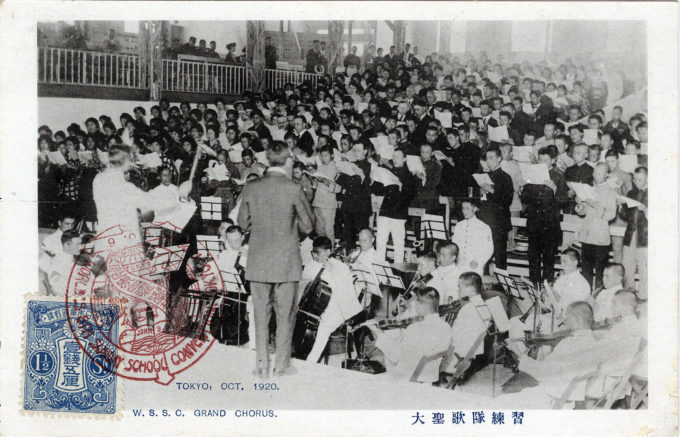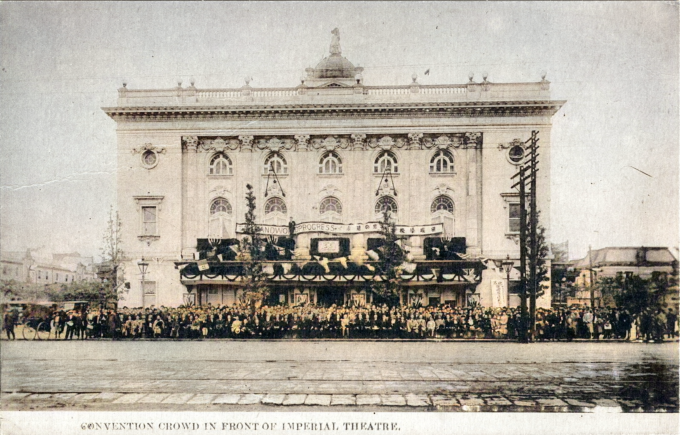
“W.S.S.C. front decoration of the hall”, Tokyo, 1920 – the gypsum statue of Christ, commissioned for the convention, blessing children of the world. The World Sunday School Association, headquartered in New York City, held its first international convention in London in 1889. Its eighth, originally planned for 1916 in Tokyo, had to be postponed until 1920 due to World War I. It was held October 5-14, 1920. The mission of the association was to promote Christian education worldwide. It served as a clearinghouse for the training of teachers (of some 30MM students in over 300,000 Sunday schools around the world), the creation of nondenominational religious curriculum and teaching materials, and the establishment of varied educational approaches. The W.S.S.A. would merge into the World Council of Churches in 1971. (Gift of J. Harper Brady Sr.)
See also:
The Teikoku Theatre, The Best Theatre in Tokyo, c. 1920-30
“On Tuesday, October 5, many delegates to Tokyo stood in admiration before that triumph of the energetic purpose of the Patrons’ Association and the Christians of Japan, the great Convention Building. They gazed at the beautiful white gypsum statue before the building, which represented Christ (with his hand on a large globe) Blessing the Children of the World, representatives of whom were gathered with the teacher on the opposite side of the globe. They wandered into the corridors and the offices, spoke appreciatively of the comfortable rest rooms and other arrangements for the pleasure of the delegates, then took seats in the great hall and looked toward the platform where places had been arranged for a thousand participants in the pageants for which plans had been made.
“Then came what at first appeared to be dire disaster.
“… The fire [in the Convention Building] originated because of imperfect wiring, and started directly above the heads of the [rehearsing] choir in the draperies that hung above the word ‘Light’ in the convention motto, ‘I am the Light of the World’. The first intimation was the crackling sound, and then Professor Smith saw the flame, scarcely larger than a man’s hand. Very wisely he acted at once, in order that no risk might be run, and dismissed the choir in an orderly manner, though nobody thought there was any serious danger, the fire seemed so small. Four of the husky young men from the choir succeeded in getting one of the pianos out of the building, and in less than ten minutes everybody was out of the house.
“Mitsuwa Soap for New Year’s gifts” advertising postcard, World Sunday School Convention, Tokyo, 1920. Indicative of the local business support for the international Christian gathering.
“… The business men who had come in to express their sympathy and offer their help at once got busy by use of the telephone, and in less than fifteen minutes had arranged for the meetings to go forward that night in the auditorium of the Y. M. C. A. and in the Salvation Army Hall, but neither building being large enough for the entire Convention. The program was duplicated that night in both places, and actually began only twenty minutes late.
“Before these same business men left the room they had taken steps toward the securing of the Imperial Theater for the use of the Convention, and at the night meeting official announcement was made that the Imperial Theater had been secured, although a contract with a company that was then occupying the building had to be canceled, a large platform built, all of which, including the contract, platform, and rental, we were told, cost something like 40,000 yen, or $20,000, for the ten days.
“… The Imperial Theater to which we went was a magnificent fireproof building in the heart of the city, and all anxiety from fire was dispelled. During the weeks before the fire it [had been] filled each night by crowds of amusement-seekers. But the company playing there was dismissed, at great financial sacrifice to the owners, and the magnificent building was placed at the disposal of the Convention. The rent was paid from the insurance on the burned building.
“… No change in program was necessary except the postponement of the opening pageant from Tuesday to Friday evening. The costumes for the pageant, so carefully prepared, were destroyed in the fire. But many of the young women who had been trained for these pageants were so full of enthusiasm that they insisted on sitting up all night to make new costumes.”
– The Sunday School and World Progress: The Official Book of the Eighth World’s Sunday School Convention, edited by John T. Faris, World Sunday School Association, 1921

“W.S.S.C. The city beautiful pageant [sic]”, Tokyo, 1920 (colorized), inside the Imperial Theatre which substituted for the destroyed Convention Building. The original pageant costumes were destroyed in the fire but were recreated almost overnight by the participants. (Gift of J. Harper Brady Sr.)
- “City Beautiful”, World Sunday School Convention, Tokyo, 1920.
- “Grand Chorus”, World Sunday School Convention, Tokyo, 1920.
“In pageantry the 1000 participants were nearly all Japanese, and here we found admirable qualities for acting Biblical narrative and Christian ideals.
“Their quiet and poise on the stage was the richest feature of it all. No giggling groups, no whispering, no shifting from one foot to another, no ragged lines, no forgotten positions. Their endurance and coolness under the rapid fire of photographers with their flash guns was great.
“Never before have Grecian gowns looked more lovely than on the Japanese young ladies with their long black hair hanging down Grecian fashion, and their easy and graceful carriage. Many principal parts were taken by Japanese who spoke with clearness and strength.
“It has been said again and again that Japan has had new visions of western music and pageantry through the recent convention successes … The personnel of chorus and pageants will carry the messages of music and art to the ends of the earth, for most of them are students who will next April scatter hither and thither for teaching, etc.
“A new day in art, music, drama, ritual (Christian) has dawned for the Sunrise Kingdom.”
(signed)
H. Augustin Smith
October 15, 1920– “How Japan Impressed W.S.S.C. Delegates”, The Tourist, January 1921
“The ten days we spent in Tokyo at the World Sunday School Convention were busy days. To attend two meetings [each day] for ten days is no small matter.
“This was a great meeting in many ways, but I have no doubts as to whether it should have ever been held in Japan. The Japanese people did everything possible to make the delegates have a good time. Such entertaining on such an immense scale was never known, and I am sure that no city in a Christian land would have undertaken such a feat.
“After the building was burned the business men and the government came right in and helped the managers arrange for other quarters. The building that burned cost something over ¥200,000. The Imperial Theater was secured for the meetings, and it was a magnificent place for such a meeting.”
– Rev. J. Archibald Brady, personal reminiscence, 1920






